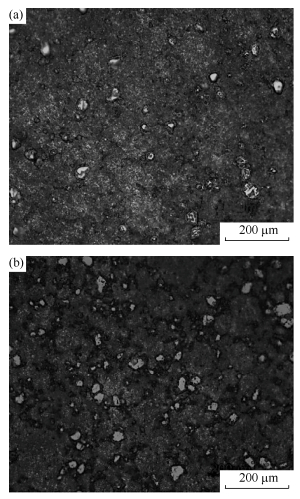| [1] |
Fan T, Sun Y R, Tang Y, et al. The study on wear resistance of SiC particle reinforced Cu matrix composites prepared by reaction milling and hot pressed sintering. Powder Metall Technol, 2015, 33(6): 432 doi: 10.3969/j.issn.1001-3784.2015.06.006范涛, 孙艳荣, 唐怡, 等.反应球磨热压烧结制备SiCp/Cu复合材料的耐磨性能研究.粉末冶金技术, 2015, 33(6): 432 doi: 10.3969/j.issn.1001-3784.2015.06.006
|
| [2] |
Zhuang J, Liu Y B, Cao Z Y. Microstructure and wear resistance of Cu–TiC composites fabricated by mechanical alloying and spark plasma sintering. Adv Mater Res, 2011, 213: 524. doi: 10.4028/www.scientific.net/AMR.213.524
|
| [3] |
Yuan X Y, Liu G H, Jin H B, et al. In situ synthesis of TiC reinforced metal matrix composite(MMC)coating by self propagating high temperature synthesis(SHS). J Alloys Compd, 2011, 509(30): L301. doi: 10.1016/j.jallcom.2011.04.150
|
| [4] |
Li Y Y, Deng Q C, Shi P, et al. Dry sliding friction and wear behavior of surface hardened ferrous PM cam materials for automobile applications. Adv Mater Res, 2013, 652-654: 1399. doi: 10.4028/www.scientific.net/AMR.652-654.1399
|
| [5] |
Suryanarayana C, Al-Aqeeli N. Mechanically alloyed nanocomposites. Prog Mater Sci, 2013, 58(4): 383. doi: 10.1016/j.pmatsci.2012.10.001
|
| [6] |
Zhuang J, Liu Y B, Cao Z Y, et al. The influence of technological process on dry sliding wear behaviour of titanium carbide reinforcement copper matrix composites. Mater Trans, 2010, 51(12): 2311. doi: 10.2320/matertrans.M2010270
|
| [7] |
Yan J, Jiang K Y. Fabrication with powder metallurgy and study on properties of TiC/Cu composites. J Chongqing Univ Technol Nat Sci, 2012, 26(9): 42 https://www.cnki.com.cn/Article/CJFDTOTAL-CGGL201209009.htm闫洁, 江开勇. TiC/Cu复合材料的PM法制备与性能.重庆理工大学学报(自然科学), 2012, 26(9): 42 https://www.cnki.com.cn/Article/CJFDTOTAL-CGGL201209009.htm
|
| [8] |
Zhang Z W, Ji Z, Jia C C, et al. Preparation and properties of copper matrix composites reinforced by CNTs and Al2O3. Powder Metall Technol, 2016, 34(5): 356 doi: 10.3969/j.issn.1001-3784.2016.05.007张政委, 纪箴, 贾成厂, 等.碳纳米管和氧化铝颗粒协同增强铜基复合材料的制备与性能研究.粉末冶金技术, 2016, 34(5): 356 doi: 10.3969/j.issn.1001-3784.2016.05.007
|
| [9] |
Bai X, Jin Y X, Lu X, et al. Influence of reinforcement content on friction and wear properties of in-situ(TiC+Ti B)/Ti6Al4V composites. Trans Mater Heat Treat, 2017, 38(5): 30 https://www.cnki.com.cn/Article/CJFDTOTAL-JSCL201705006.htm白雪, 金云学, 卢璇, 等.增强相含量对原位自生(TiC+TiB)/Ti6Al4V复合材料摩擦磨损性能的影响.材料热处理学报, 2017, 38(5): 30 https://www.cnki.com.cn/Article/CJFDTOTAL-JSCL201705006.htm
|
| [10] |
Lin S J, Xiong W H, Wang S Y, et al. Effect of reinforcing particles content on properties of TiC/316L composites. Mater Sci Eng Powder Metall, 2013, 18(3): 373 doi: 10.3969/j.issn.1673-0224.2013.03.011蔺绍江, 熊惟皓, 王赛玉, 等.增强体含量对TiC/316L复合材料性能的影响.粉末冶金材料科学与工程, 2013, 18(3): 373 doi: 10.3969/j.issn.1673-0224.2013.03.011
|
| [11] |
Wang X L, Ding H M, Qi F G, et al. Mechanism of in situ synthesis of TiC in Cu melts and its microstructures. J Alloys Compd, 2017, 695: 3410. doi: 10.1016/j.jallcom.2016.12.018
|
| [12] |
Li M Q, Zhai H X, Huang Z Y, et al. Tensile behavior and strengthening mechanism in ultrafine TiC0.5 particle reinforced Cu–Al matrix composites. J Alloys Compd, 2015, 628: 186. doi: 10.1016/j.jallcom.2014.10.123
|
| [13] |
Li M Q, Zhai H X, Huang Z Y, et al. Microstructure and mechanical properties of TiC0.5 reinforced copper matrix composites. Mater Sci Eng A, 2013, 588: 335. doi: 10.1016/j.msea.2013.09.054
|
| [14] |
Gedam V, Pansari A, Sinha A K, et al. The effect of macroscopic polarization on intrinsic and extrinsic thermal condutivities of Al N. J Phys Chem Solids, 2015, 78: 59. doi: 10.1016/j.jpcs.2014.10.024
|
| [15] |
Eddine W Z, Matteazzi P, Celis J P. Mechanical and tribological behavior of nanostructured copper-alumina cermets obtained by pulsed electric current sintering. Wear, 2013, 297(1-2): 762. doi: 10.1016/j.wear.2012.10.011
|




 下载:
下载:







